 If you provide a specific area of plants to serve as butterfly magnets it should be in full sun. Avoid the use of pesticides for obvious reasons. And make sure there is a water source nearby as well as some shelter.
If you provide a specific area of plants to serve as butterfly magnets it should be in full sun. Avoid the use of pesticides for obvious reasons. And make sure there is a water source nearby as well as some shelter.
Supply host plants on which eggs can be laid, so that a ready food source is at hand for emerged caterpillars. Provide nectar-rich perennials to feed adult butterflies. This will ensure that your garden is not only enriched by the beauty of butteflies but also helped by their pollinating efforts.
The many plant combinations below will ensure that your gardens are alive with the beauty and activity of many butterfly species.
* Watch for the animated hummingbird and butterfly with the plants that attract them. *
The deer icon indicates plants that deer are not usually attracted to.
   The best time and method to propagate plants can be found on our image-intensive PROPAGATION page.
To help your plants grow their best, check out our FERTILIZATION page.
To create your own plant partnerships based on tried and true color theory, check out our GARDEN COLOR page.
To see if a particular plant is on this page press Ctrl+F, type in the name, then click the Find button.
The best time and method to propagate plants can be found on our image-intensive PROPAGATION page.
To help your plants grow their best, check out our FERTILIZATION page.
To create your own plant partnerships based on tried and true color theory, check out our GARDEN COLOR page.
To see if a particular plant is on this page press Ctrl+F, type in the name, then click the Find button.
HESPERIS
 The four flower petals of the genus Hesperis distinguish it from forms of Phlox for which it is often mistaken. Best in full sun, with moist well-drained soil, this upright perennial or biennial has purple or white blooms in May-June with a strong fragrance in the evening. After bloom the plant goes dormant and should be cut down as soon as it yellows. Allow some seeding to ensure plants for subsequent years.
Hesperis matronalis: Sweet Rocket, 2-1/2'x2', narrow serrated leaves
The four flower petals of the genus Hesperis distinguish it from forms of Phlox for which it is often mistaken. Best in full sun, with moist well-drained soil, this upright perennial or biennial has purple or white blooms in May-June with a strong fragrance in the evening. After bloom the plant goes dormant and should be cut down as soon as it yellows. Allow some seeding to ensure plants for subsequent years.
Hesperis matronalis: Sweet Rocket, 2-1/2'x2', narrow serrated leaves
LIATRIS
  Looking unlike any other Aster in which family it belongs, Blazing Star produces flower spikes that appear fuzzy or feathery and open from the top down. This is a North American wildflower, loved by birds, butterflies and bees. Cut flowers add an exotic look to floral arrangements. Plant this perennial in full sun and provide the well-drained soil preferred and you can enjoy a mid-summer to early fall display.
Liatris: Blazing Star, Gayfeather
Looking unlike any other Aster in which family it belongs, Blazing Star produces flower spikes that appear fuzzy or feathery and open from the top down. This is a North American wildflower, loved by birds, butterflies and bees. Cut flowers add an exotic look to floral arrangements. Plant this perennial in full sun and provide the well-drained soil preferred and you can enjoy a mid-summer to early fall display.
Liatris: Blazing Star, Gayfeather
with: Solidago canadensis
in front of: Anchusa azurea (A. italica), Achillea, Artemisia, Chrysanthemum x superbum,
Gypsophila paniculata, Heliopsis, Phlox paniculata
including white 'Mt. Fujiyama',
Perovskia atriplicifolia, Echinops ritro, Ornamental Grasses
offset in front of: Echinacea purpurea (white forms), Malva alcea, Malva moschata 'Alba'
combined with: Echinacea purpurea, Echinacea purpurea 'White Swan' & Buddleia
Liatris ligulistylis: 3-5 ft. crimson buds open rosy-purple
where: to attract butterflies & goldfinches
with: Echinacea purpurea 'White Swan'
combined with: Alcea rugosa (A. ficifolia), Echinops ritro & Buddleia 'Red Plume'
Liatris microcephala: 12-14", rose-purple
where: front of border (its grass-like foliage must be kept out of the lawn)
with: Calamintha nepetoides
Liatris pycnostachya: purple, 4', July-August bloom
where: moist areas
with: Phlox paniculata ‘Mt. Fujiyama’
Liatris scariosa 'September Glory': Eastern (or New England) Blazing Star, Devil's Bite
with: Lythrum 'Robert' & Achillea x 'Moonshine'
Liatris spicata: rosy-purple 3', Spike Gayfeather
where: meadow, prairie & perennials gardens, near ponds or streams
generally with: pale yellows
with other butterfly magnets: pale mauve Monarda fistulosa, Echinacea purpurea, Rudbeckia fulgida 'Goldsturm',
with: Achillea, Artemisia, Chrysanthemum x superbum, Heuchera 'Palace Purple', Ornamental Grasses
combined with: Liatris 'Kobold' & Platycodon grandiflorus 'Alba'
above trio with: Pulmonaria saccharata 'Mrs. Moon' & Delphinium elatum 'Blue Connecticut Yankee'
Liatris spicata: white forms
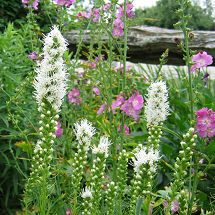
seen in the picture above with: soft pink Sidalcea malviflora 'Mr. Lingbergh'
with: Jasione perennis 'Blue Light'
for more ideas see Liatris spicata 'Floristan White' combinations below
Liatris spicata 'Floristan Violet'
with: Geranium (hardy species), Iris pseudacorus, Lysimachia punctata, Lupinus, Dianthus (alpine), Kniphofia uvaria
Liatris spicata 'Floristan White': 24-36", pure white, July-August bloom
with: Achillea, Echinacea purpurea, Artemisia, Chrysanthemum x superbum, Phlox paniculata,
combined with: Heuchera 'Palace Purple', Liatris spicata (purple forms), Origanum 'Herenhausen' &
all white combination with: Physostegia virginiana, Lilium 'Casa Blanca' & Phlox paniculata 'Mt. Fujiyama'
Liatris spicata 'Kobold': reddish-lilac, only 24-30" tall but a strong vertical element
where: front to mid-border
with other butterfly magnets: Solidago canadensis, Phlox paniculata (white)
with: white Platycodon grandiflorus 'Alba', cool yellow Coreopsis verticillata 'Moonbeam'
More interesting Liatris information can be found by following the links below.
purple Liatris
white Liatris
LIMONIUM
  Sea Lavender, sometimes called Statice, has been described as a baby's breath look-alike plant because its flowers appear in airy clusters. It is happiest in either full sun or partial shade with rich, moist, well-drained soil.
Limonium latifolium: Sea Lavender
Try the links below for additional information about Sea Lavender.
white Sea Lavender
silver foliage Sea Lavender
Sea Lavender, sometimes called Statice, has been described as a baby's breath look-alike plant because its flowers appear in airy clusters. It is happiest in either full sun or partial shade with rich, moist, well-drained soil.
Limonium latifolium: Sea Lavender
Try the links below for additional information about Sea Lavender.
white Sea Lavender
silver foliage Sea Lavender
MONARDA
   Known also as Bergamot and Horsemint, Bee Balm produces ragged-looking flowers in a variety of colours above fragrant foliage. This is another North American wildflower. Plant the red types especially to bring hummingbirds to your garden in droves. Moist soil and frequent division will keep your plants healthy.
Monarda didyma: Bee Balm
Known also as Bergamot and Horsemint, Bee Balm produces ragged-looking flowers in a variety of colours above fragrant foliage. This is another North American wildflower. Plant the red types especially to bring hummingbirds to your garden in droves. Moist soil and frequent division will keep your plants healthy.
Monarda didyma: Bee Balm
where: formal or informal gardens, herb gardens
with: Achillea, Anthemis including A. tinctoria 'Kelwayi', Astilbe, Chrysanthemum spp, Dodecatheon meadia,
Geranium, Helenium, Lilium, Lysimachia clethroides, Platycodon including
P. grandiflorus var. Mariesii Blue, Scabiosa, Stokesia laevis
combined with: Veronicastrum (Veronica virginica), Boltonia 'Pink Beauty' & Phlox paniculata 'Franz Schubert'
with other butterfly magnets: Echinacea purpurea, Phlox paniculata (including white 'Mt. Fujiyama'),
Rudbeckia including R. 'Goldsturm' or 'Marmalade', Rudbeckia laciniata 'Goldquelle'
with bulbs: Allium including A. aflatunense, A. giganteum, A. schoenoprasum, A. senescens
(a rosy-purple butterfly magnet)
in moist areas with: Eupatorium, Filipendula, Filipendula rubra, Hibiscus, Ferns
Monarda didyma: red
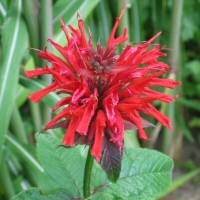
beside: Aconitum (cool blue, violet or blue & white forms)
behind: Stokesia laevis
in front of: Delphinium (blue)
with other butterfly magnets: Hemerocallis (fruit shades), Rudbeckia 'Goldsturm'
with whites: Artemisia 'Guizho', Chrysanthemum x superbum 'Alaska' or 'Diener's Double', Veronicastrum virginicum
combined with: white Veronicastrum virginicum, Aconitum bicolor 'Bicolor' & Hemerocallis (peachy shades)
in front of: Gypsophila paniculata, ivory Lilium martagon (Turk's Cap Lily) & Delphinium (blue)
Monarda: pink
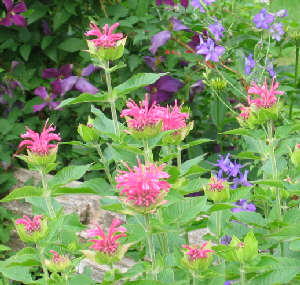
seen above in front of: bluish-purple annual Delphinium Consolida ajacis & deep purple Clematis 'Polish Spirit'
with: Achillea 'Moonshine', Filipendula rubra 'Venusta', Phlox paniculata (rose forms)
in front of: Aconitum
behind: Anthemis tinctoria 'Kelwayi'
combined with: Lilium (white Asiatic) & Tanacetum (Feverfew) all behind a purple-spiked perennial
(such as Veronica spp.) in front
combined with: Lilium 'Pink Perfection' in front of Aconitum & behind Gypsophila 'Rosy Veil'
pastel combination with: Echinacea purpurea, Stachys byzantina, Verbena, Geranium spp &
with: Filipendula rubra 'Venusta'
Monarda 'Blue Stocking'

combined with: Echinacea purpurea 'White Swan', Lilium 'Mount Everest & Monarda 'Marshall's Delight'
Monarda didyma 'Cambridge Scarlet': brilliant scarlet
combined with: Achillea x 'Moonshine' & Astilbe x arendsii 'Deutschland'
in front of: Aconitum, with white Chrysanthemum x superbum
with: Hemerocallis 'Hyperion' (canary-yellow)
Monarda didyma 'Croftway Pink': soft pink
with: Chrysanthemum x superbum
combined with: Achillea x 'Moonshine' & Astilbe x arendsii 'Deutschland'
combined with: Anthemis tinctoria 'Kelwayi '& Hibiscus spp. (bright pink)
Monarda didyma 'Gardenview Scarlet': brilliant red
in front of: Aconitum with white Chrysanthemum x superbum (Shasta Daisy)
combined with: Artemisia lactiflora, Lobelia 'Compliment Scarlet' & Rudbeckia 'Goldsturm'
Monarda didyma 'Marshall's Delight': bright and showy hot-pink
with: Astilbe, Chrysanthemum parthenium, Echinacea purpurea 'White Swan'
in front of: Delphinium (light blue)
Monarda didyma 'Snow Queen': white
Monarda 'Violet Queen': deep violet-purple, purple-blue
with: Lilium, Phlox paniculata, Achillea, Geranium, Astilbe
in moist areas with: Eupatorium, Filipendula rubra, Hibiscus, Ferns
Monarda fistulosa: Wild Bergamot
Do you need more useful information about growing Bee Balms? Follow the links below.
blue Bee Balm
pink Bee Balm
red Bee Balm
white Bee Balm
MYRRHIS
  There is only one species in this genus. Sweet Cicely will grow in sun or shade in well-drained soil. Everything about this graceful perennial is attractive, from the ferny green foliage to the fragrant fuzzy-looking white flowers. When I saw this plant with the white effect described below in Patrick Lima's book - The Art of Perennial Gardening, Creative Ways With Hardy Flowers - I knew I'd found a combination I couldn't wait to try out.
Myrrhis odorata
There is only one species in this genus. Sweet Cicely will grow in sun or shade in well-drained soil. Everything about this graceful perennial is attractive, from the ferny green foliage to the fragrant fuzzy-looking white flowers. When I saw this plant with the white effect described below in Patrick Lima's book - The Art of Perennial Gardening, Creative Ways With Hardy Flowers - I knew I'd found a combination I couldn't wait to try out.
Myrrhis odorata
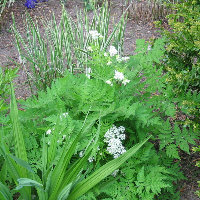
seen above in front of: the emerging foliage of Miscanthus sinensis 'Variegatus' and beside a boxwood shrub
for a white effect behind: Tulipa 'Spring Green' (white with green veining), underplanted with white Lamium &
Miscanthus sinensis 'Variegatus' nearby
with: scarlet Oriental Poppies
If you want to know more about this perennial, follow the link below.
white Sweet Cicely
PHLOX
  Butterflies will be drawn to the aroma of flowers in the genus Phlox, particularly the mid-summer blooming Garden Phlox, Phlox paniculata.
Phlox decussata 'David': white, mildew-resistant
Butterflies will be drawn to the aroma of flowers in the genus Phlox, particularly the mid-summer blooming Garden Phlox, Phlox paniculata.
Phlox decussata 'David': white, mildew-resistant
combined with: Rudbeckia, Aster 'Hella Lacy' & Coreopsis 'Goldfink'
Phlox maculata 'Miss Lingard': Wild Sweet William, cool white, fragrant, early-blooming, June-July
with: Hemerocallis 'Pink Lavender Appeal' (unusual colour)
with: Nepeta sibirica
combined with: Linum perenne & Tulipa (white or yellow)
combined with: Campanula lactiflora 'White Flower Farm Selection' (a mid-blue), Digitalis ambigua &
Phlox maculata 'Rosalinde': Wild Sweet William
Phlox paniculata: Garden Phlox, Summer Phlox, Summer Perennial Phlox
where: informal or formal gardens, woodland edges, rich, moist, well-drained sites
for contrast with spiky plants: Cimicifuga racemosa, Digitalis, Crocosmia x crocosmiiflora, Iris x germanica,
Veronica longifolia, Veronicastrum virginicum
for shape contrast with rounded plants: Echinops ritro, Geranium, Gypsophila paniculata
with Ornamental Grasses: Miscanthus sinensis 'Silberfeder'
with: Artemisia, Artemisia lactiflora, Chelone lyonii, Chrysanthemum x superbum (Shasta Daisy),
Coreopsis verticillata 'Moonbeam', Erigeron 'Profusion', Erigeron speciosus, Filipendula, Filipendula rubra, Filipendula rubra 'Venusta'
with: Goniolinum tartaricum, Helenium autumnale, Heliopsis, Kniphofia, Liatris, Limonium latifolium, Lobelia siphilitica, Lythrum salicaria 'Morden Pink', Malva alcea, Malva moschata 'Alba', Patrinia scabiosifolia 'Nagoya', Physostegia virginiana, Platycodon, Polemonium caeruleum, Sanguisorba canadensis, Scabiosa caucasica, Sidalcea including bright pink 'Party Girl', Stokesia laevis
with: Aconitum including Aconitum x cammarum 'Bicolor' (violet and white)
with: Eryngium including E. amethystinum, E. planum, E. tripartitum or hybrids
in front of: Anchusa, Delphinium (tall types), Digitalis
behind: Oenothera macrocarpa (formerly O. missouriensis)
in shade with: Astilbe
with other butterfly magnets: Aster, Aster x frikartii, Echinacea purpurea, Eupatorium, Helianthus, Hemerocallis,
Monarda including 'Violet Queen' (deep violet purple), Rudbeckia including 'Goldsturm', 'Goldquelle' and 'Marmalade', Solidago canadensis
behind: Anthemis tinctoria, Aquilegia, Iris
beside: Paeonia, Papaver orientale
combined with: Calamintha, Gypsophila paniculata 'Perfecta' & Perovskia atriplicifolia
Phlox paniculata: cherry
with: Filipendula rubra 'Venusta'
Phlox paniculata: hot pink
with: Veronicastrum virginicum (white)
Phlox paniculata: magenta
with: Filipendula rubra 'Venusta'
with: Thalictrum aquilegiafolium, Thalictrum delavayi 'Hewitt's Double'
behind: Elymus arenarius (Sea Lyme Grass) with Lavatera 'Silver Cup' (bright pink veined with maroon) &
Cosmos (mauve or wine-red)
Phlox paniculata: orange forms
Phlox paniculata: pastel shades
especially nice with: Echinops ritro
Phlox paniculata: pink
with: Aconitum pyrenaicum (yellow)
with: Artemisia ludoviciana (Silver Sage)
with: Chrysanthemum parthenium (now Tanacetum parthenium)
combined with: Cimicifuga racemosa & hardy white Lilies
combined with: Artemisia ludoviciana & crimson-coloured roses
Phlox paniculata: pink - soft tones
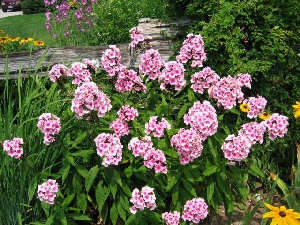
the cultivar above is 'Europa' with very light pink petals and a much darker pink eye
with: Thalictrum aquilegiafolium
Phlox paniculata: purple forms
in front of: Delphinium 'Black Knight' (gorgeous)
with: Aconitum, Lythrum, Cimicifuga, Chrysanthemum x superbum, Artemisia lactiflora,
Phlox paniculata: reds
with: Ligularia stenocephala 'The Rocket'
Phlox paniculata: rose-coloured forms
Phlox paniculata: salmon
not with: Filipendula rubra 'Venusta'
Phlox paniculata: strong-coloured forms
in front of: Miscanthus sinensis
behind: Helictotrichon sempervirens
Phlox paniculata: white forms
with: Achillea 'Summer Pastels', Delphinium, Echinacea purpurea, Erigeron, Filipendula, Geranium,
Helenium autumnale, Helianthus, Heliopsis, Liatris, Patrinia scabiosifolia, Platycodon, Salvia x superba, Thalictrum aquilegiafolium
with: Iris x germanica (blue or light yellow), Centaurea montana, Rudbeckia 'Goldsturm'
in front of: Aconitum (violet), Aconitum (blue & white)
in front of: Digitalis, Anchusa
behind: Hemerocallis (peach & apricot shades)
behind: Astilbe, Iris, Aquilegia
with: Ornamental Grasses
with other butterfly magnets: Eupatorium, Monarda, Hemerocallis
combined with: Campanula lactiflora 'Loddon Anna' (soft pink), Perovskia atriplicifolia & Caryopteris
combined with: Aconitum (dark blue) & Hemerocallis (melon-coloured form feathered with red)
combined with: Achillea filipendulina 'Gold Plate', Hemerocallis (tawny-coloured) & Aconitum x bicolor
Phlox paniculata 'Barnwell': pink

imagine this magnetic pink beauty in combinations suggested generally for pink forms above
Phlox paniculata 'Bright Eyes': pink flowers with crimson eyes, mildew-resistant
note: sweet fragrance attracts both butterflies and hummingbirds
combined with: Sanguisorba obtusa, Geranium psilostemon & Centranthus 'Snowcloud'
Phlox paniculata 'Eva Cullum': bright pink
with: Polemonium caeruleum
Phlox paniculata 'Franz Schubert': lilac-blue with purple eye, long-blooming, 30-36"
generally with: blues, whites, pale yellows
with: Polemonium caeruleum
late blooming combo with: Veronicastrum virginicum, Boltonia 'Pink Beauty' & Monarda
combined with: Artemisia ludoviciana 'Silver King & Hemerocallis 'Joan Senior'
Phlox paniculata 'Mt. Fujiyama': sparkling white with a soft golden eye, 26"
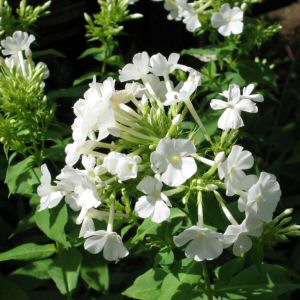
for even more companions refer to: Phlox paniculata - white forms - above
with: Chrysanthemum x superbum
combined with other white flowered perennials: Physostegia, Lilium 'Casa Blanca' & Liatris 'Floristan White'
between strong colours: Achillea x 'Coronation Gold', Coreopsis verticillata 'Moonbeam', Liatris pycnostachya, Miscanthus 'Silberfeder' & Lilium 'Sans Souci'
with other butterfly magnets: Monarda didyma
combined with: Perovskia atriplicifolia & Coreopsis verticillata 'Moonbeam'
Phlox paniculata 'Sandra': rich orange-pink, 20"
with: white flowers, silver-leaved plants
Phlox paniculata 'White Admiral': 36", giant white flower
with: Achillea 'Red Beauty'
Follow the links below for more partnership ideas and information about Phlox.
Phlox for edging
blue Phlox
orange Phlox
pink Phlox
red Phlox
Phlox for shade
white Phlox
Phlox with variegated foliage
RUTA
 Rue is a genus of evergreen summer-flowering sub-shrubs. Foliage is deeply divided and aromatic. Small mustard-yellow flowers appear in clusters. These should be removed while in bud if it is the impact of the foliage you want to highlight. Prune back to old wood only in the spring to keep the plant compact. Semi-ripe cuttings may be taken in summer for propagation purposes. If you spot caterpillars on the foliage do not spray. Rue is favoured by the larvae of the monarch butterfly.
Ruta graveolens: 1-3'x2'
Rue is a genus of evergreen summer-flowering sub-shrubs. Foliage is deeply divided and aromatic. Small mustard-yellow flowers appear in clusters. These should be removed while in bud if it is the impact of the foliage you want to highlight. Prune back to old wood only in the spring to keep the plant compact. Semi-ripe cuttings may be taken in summer for propagation purposes. If you spot caterpillars on the foliage do not spray. Rue is favoured by the larvae of the monarch butterfly.
Ruta graveolens: 1-3'x2'
SEDUM
 Border varieties of this genus, both upright in habit and late-blooming, provide a landing platform for butterflies who appreciate their large flower clusters. Bees will be drawn to them as well. This may be considered a bonus or a drawback.
Border varieties of this genus, both upright in habit and late-blooming, provide a landing platform for butterflies who appreciate their large flower clusters. Bees will be drawn to them as well. This may be considered a bonus or a drawback.
Sedum spectabile: Showy Stonecrop
with: hybrid Tulipa, Achillea, Echinacea purpurea, Geranium, Coreopsis, Ornamental Grasses,
with: blue forms of Aster novi-belgii, Aster novae-angliae, Aster x frikartii
combined with: Eupatorium (lavender-blue) & Salvia x superba
Sedum 'Autumn Joy': salmon-pink, darkening as it ages

with shrubs: Berberis thunbergii 'Atropurpurea', Caryopteris x clandonensis 'Blue Mist' (lavender-blue)
or 'Dark Knight' (violet-blue)
with other butterfly magnets: Asclepias tuberosa, Aster (Michaelmas Daisy), blue New England or New York types,
Aster frikartii (any blues), Aster novae-angliae 'Alma Potschke' (deep salmon-pink), Aster novae-angliae 'Autumn Snow', Aster novi-belgii 'Benary's Composition Mix', Rudbeckia including 'Goldquelle', 'Goldsturm' and 'Marmalade'
combined with: Rudbeckia 'Goldsturm' & Pennisetum alopecuroides
with: Chrysanthemum x superbum (Shasta Daisy), Echinops ritro
with: Sanguisorba canadensis
with: Eupatorium coelestinum, Helenium autumnale 'Brilliant', Helenium 'Hoopesii', Helianthus decapetalus,
behind: Dianthus 'Aqua', Geranium sanguineum striatum, Potentilla 'Firedance'
with: Ornamental Grasses including Festuca, tall Miscanthus sinensis 'Gracillimus', Pennisetum alopecuroides,
in front of: Papaver orientale to hide the poppy's foliage when it dies back, Achillea 'Coronation Gold'
between: Yucca smalliana & Stachys byzantina
behind: Hosta sieboldiana 'Elegans'
beside: Aster 'Little Blue Boy' (dwarf), Aster ericoides 'Blue Star'
beside: Coreopsis verticillata 'Golden Showers' or 'Moonbeam', Kniphofia 'Royal Castle Hybrids',
Salvia farinacea 'Victoria' (annual)
in front of: Artemisia 'Powis Castle', Boltonia asteroides
with: Perovskia atriplicifolia, Physostegia virginiana 'Alba', Verbena bonariensis
behind: Artemisia schmidtiana nana 'Silver Mound'
Sedum spectabile 'Brilliant': bright rose-pink
never with: Sedum 'Autumn Joy' (their colours clash terribly)
note: it is safe to use many of the same companions as for 'Autumn Joy' however without clashes
with: Veronicastrum virginicum
Sedum spectabile 'Carmen'
behind: Gonioliunum tartaricum
in front of: Perovskia atriplicifolia
with: Helianthemum 'Wisley Pink'
with: Campanula carpatica 'White Clips'
Sedum spectabile 'Stardust': blue-green foliage, white flowers
beside: Eryngium bourgatii
behind: Limonium latifolium
in front of: Centranthus ruber
Try the following links for more information about and partnership ideas for Sedums.
Sedums for edging
red Sedums
Sedums with silver foliage
white Sedums
yellow Sedums
Sedums with variegated foliage
SOLIDAGO

 Goldenrod does not cause hay fever so can be safely added to your gardens in full sun to light shade for late summer colour. This plant tolerates drought and is available in many desirable cultivars including those shown below.
Goldenrod does not cause hay fever so can be safely added to your gardens in full sun to light shade for late summer colour. This plant tolerates drought and is available in many desirable cultivars including those shown below.
Solidago: Goldenrod
Solidago 'Golden Shower'
Solidago 'Peter Pan'
Solidago sphacelata 'Golden Fleece'
Follow the link below for more partnership ideas for and information about Goldenrod.
yellow Goldenrod forms
VERBENA

 A clear favourite with British garden writer, Christopher Lloyd, this tender perennial that often self-sows will continue blooming into October. Surely this is a welcome addition to any garden.
A clear favourite with British garden writer, Christopher Lloyd, this tender perennial that often self-sows will continue blooming into October. Surely this is a welcome addition to any garden.
Verbena bonariensis: tender perennial, deep purple, 4-5', Zone 7
formerly: V. patagonica
nearly as appealing to butterflies as Buddleia
where: especially attractive in mass plantings
with: Hemerocallis
with: Lavandula, Achillea, Sedum, Echinacea purpurea, Echinops, Yucca
with other butterfly attractors: Eupatorium (Joe-Pye-weed), Buddleia
You can find more information about and partners for Verbena by following the link below.
pink Verbena forms
VERONICASTRUM
 Also called Bowman's Root and Blackroot as well as Culver's Root, this elegant late summer blooming perennial will add height and structure to the mid to rear areas of any border with full sun and well-drained, fertile soil. Flower spikes can bring the height of this plant to from 4-7 feet. Provide ample fertilization for best results.
Also called Bowman's Root and Blackroot as well as Culver's Root, this elegant late summer blooming perennial will add height and structure to the mid to rear areas of any border with full sun and well-drained, fertile soil. Flower spikes can bring the height of this plant to from 4-7 feet. Provide ample fertilization for best results.
Veronicastrum virginicicum: Culver's Root
synonym: Veronica virginica
where: sun to light shade, average to damp soil
generally with: white & blue perennials, foliage plants (i.e. Hosta, Ornamental Grasses)
with other butterfly magnets: Hemerocallis, Phlox paniculata, Rudbeckia
with: Aconitum, Anemone japonica, Angelica gigas, Helenium autumnale, Monarda didyma
late blooming combination with: Boltonia 'Pink Beauty', Monarda & Phlox paniculata 'Franz Schubert'
combined with: Helenium autumnale 'Brilliant' & Sedum 'Autumn Joy'
combined with: Anemone tomentosa 'Robustissima', Cimicifuga & Thalictrum
Veronicastrum virginicum 'Album': very white flowers, dark foliage
with: Phlox paniculata (hot pink), Monarda (red) & Hemerocallis (peachy tones)
in light shade with: Aconitum (violet), Aconitum bicolor 'Bicolor'
behind: pink Hemerocallis
combined with: Hemerocallis 'Joan Senior', Miscanthus sinensis 'Silberfeder' & Achillea 'Coronation Gold'
If you are looking for more information about and companions for Culver's Root, you will find them at the link below.
white Culver's Root
FOLLOW THE LINK BELOW TO THE FIRST PAGE OF BUTTERFLY-ATTRACTING PERENNIALS & THEIR COMPANIONS.
All of our own Gardens By The Bay pages can be accessed by clicking on the links below.
HOME
GARDEN POETRY |
GARDEN POETRY MUSE
GEORGIAN BAY VIEW
BOTANICAL LATIN - BASICS
COLOR THEORY
THE GARDENS
CORNER GARDEN CONSTRUCTION |
CORNER GARDEN PLANTING |
LONG GARDEN
EAST GARDEN |
HOSTA GARDEN |
NORTH GARDEN |
WINTER GARDENS
PLANT PARTNERSHIPS
BLUE PERENNIALS Aconitum -
Geranium |
Iris - Vinca
BULBS Allium - Hyacinthus |
Narcissus only |
Tulipa only |
Minor Bulbs
BUTTERFLY MAGNETS Anaphalis - Hemerocallis |
Liatris - Veronicastrum
 DAYLILIES Spider & Unusual Form DAYLILIES Spider & Unusual Form EDGERS Arabis - Iris |
Nepeta - Veronica
FOLIAGE PERENNIALS
Alchemilla - Tanacetum
HOSTA Hosta - all
HUMMINGBIRD-FRIENDLY PERENNIALS Alcea - Salvia
ORANGE PERENNIALS Achillea - Tulipa
ORNAMENTAL GRASSES Acorus - Imperata |
Miscanthus - Spodiopogon
PINK PERENNIALS Achillea - Lilium |
Lychnis - Veronica
PURPLE PERENNIALS Aconitum - Liatris |
Polemonium - Veronica
RED PERENNIALS Achillea - Veronica
SHADE PERENNIALS Aegopodium - Erythronium |
Ferns - Polemonium |
Polygonatum - Vinca
SILVER FOLIAGE PERENNIALS
Achillea - Cerastium
|
Cornus - Limonium
|
Lunaria - Veronica
SIMPLY SPECIAL PERENNIALS Acanthus - Saxifraga
WHITE PERENNIALS Achillea - Iris |
Kalimeris - Yucca
YELLOW PERENNIALS Achillea - Hypericum |
Inula - Verbascum
VARIEGATED-FOLIAGE PERENNIALS Acorus - Erythronium |
Hakonechloa - Lysimachia |
Miscanthus - Yucca
PLANT PROFILES
Dianthus 'Tiny Rubies' |
Geranium |
Geum coccineum |
Kerria japonica |
Knautia macedonica
Paeonia tenuifolia |
Papaver somniferum |
Rudbeckia |
Salvia 'East Friesland'
Trollius |
Veronica 'Sunny Border Blue'
PROPAGATION
DIVISION - SPRING ONLY |
DIVISION - FALL ONLY |
DIVISION - SPRING OR FALL |
DO NOT DIVIDE
FERTILIZATION
EDGERS Arabis - Iris |
Nepeta - Veronica
FOLIAGE PERENNIALS
Alchemilla - Tanacetum
HOSTA Hosta - all
HUMMINGBIRD-FRIENDLY PERENNIALS Alcea - Salvia
ORANGE PERENNIALS Achillea - Tulipa
ORNAMENTAL GRASSES Acorus - Imperata |
Miscanthus - Spodiopogon
PINK PERENNIALS Achillea - Lilium |
Lychnis - Veronica
PURPLE PERENNIALS Aconitum - Liatris |
Polemonium - Veronica
RED PERENNIALS Achillea - Veronica
SHADE PERENNIALS Aegopodium - Erythronium |
Ferns - Polemonium |
Polygonatum - Vinca
SILVER FOLIAGE PERENNIALS
Achillea - Cerastium
|
Cornus - Limonium
|
Lunaria - Veronica
SIMPLY SPECIAL PERENNIALS Acanthus - Saxifraga
WHITE PERENNIALS Achillea - Iris |
Kalimeris - Yucca
YELLOW PERENNIALS Achillea - Hypericum |
Inula - Verbascum
VARIEGATED-FOLIAGE PERENNIALS Acorus - Erythronium |
Hakonechloa - Lysimachia |
Miscanthus - Yucca
PLANT PROFILES
Dianthus 'Tiny Rubies' |
Geranium |
Geum coccineum |
Kerria japonica |
Knautia macedonica
Paeonia tenuifolia |
Papaver somniferum |
Rudbeckia |
Salvia 'East Friesland'
Trollius |
Veronica 'Sunny Border Blue'
PROPAGATION
DIVISION - SPRING ONLY |
DIVISION - FALL ONLY |
DIVISION - SPRING OR FALL |
DO NOT DIVIDE
FERTILIZATION
BULBS |
ORNAMENTAL GRASSES |
PERENNIALS |
SHRUBS |
VINES
LINKS
GARDENS |
LOCAL GARDENS |
BOTANICAL TERMINOLOGY
GARDENING BOOKS |
NON-GARDENING
HOME
|